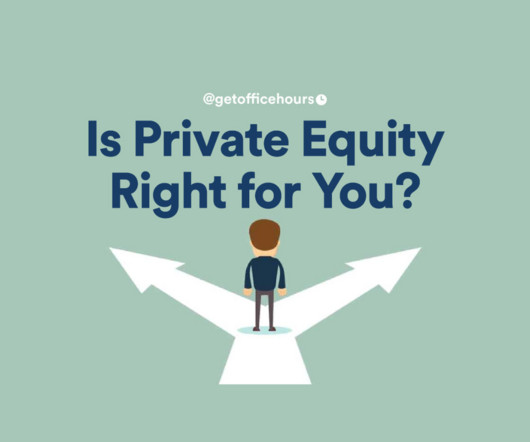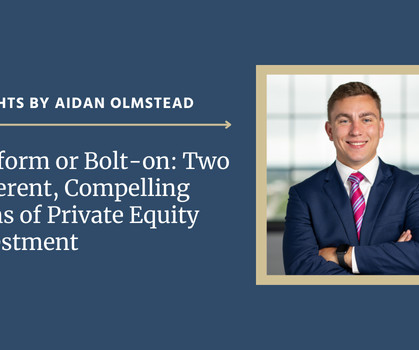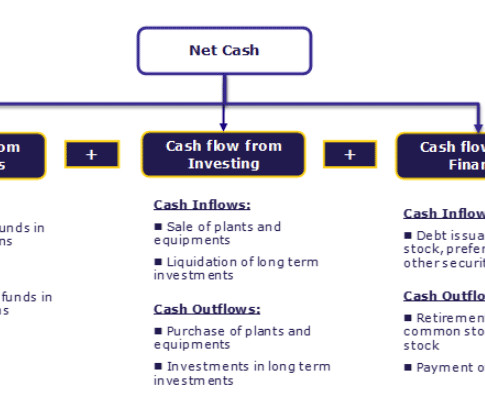Eyes on the exit: Selling PE portfolio companies in complex markets
JD Supra: Mergers
MARCH 19, 2025
By: White & Case LLP
This site uses cookies to improve your experience. To help us insure we adhere to various privacy regulations, please select your country/region of residence. If you do not select a country, we will assume you are from the United States. Select your Cookie Settings or view our Privacy Policy and Terms of Use.
Cookies and similar technologies are used on this website for proper function of the website, for tracking performance analytics and for marketing purposes. We and some of our third-party providers may use cookie data for various purposes. Please review the cookie settings below and choose your preference.
Used for the proper function of the website
Used for monitoring website traffic and interactions
Cookies and similar technologies are used on this website for proper function of the website, for tracking performance analytics and for marketing purposes. We and some of our third-party providers may use cookie data for various purposes. Please review the cookie settings below and choose your preference.

JD Supra: Mergers
MARCH 19, 2025
By: White & Case LLP

OfficeHours
JUNE 6, 2023
Private equity is an investment asset class that has gained significant prominence and popularity in recent decades. It has become a preferred choice for investors seeking attractive returns and diversification from traditional investment options such as stocks and bonds.
This site is protected by reCAPTCHA and the Google Privacy Policy and Terms of Service apply.

OfficeHours
OCTOBER 16, 2023
For private equity investors, one of the most important considerations for a successful investment is determining the value the firm will receive at exit, which directly impacts fund returns. Private equity investors often have a 5 to 7-year investment horizon and expect a significant return at the end of this hold period.

OfficeHours
OCTOBER 20, 2023
For private equity investors who have been monitoring the situation around inflation for the last few months to a year, many have been disappointed to see the slow trajectory with which inflation has been coming down from highs. Explore the role of private equity now. Currently, inflation in the U.S.

OfficeHours
OCTOBER 23, 2023
However, for private equity investors, this uncertainty represents a unique opportunity to take advantage of investment opportunities in public markets. A “take-private” transaction in the context of private equity is a process by which a PE firm acquires a publicly listed company and converts it into a privately held entity.

OfficeHours
AUGUST 9, 2023
To know if the buyside is right for you, let’s start with a textbook understanding of “What is private equity?” Private equity involves investing capital directly into private businesses that are not publicly traded on stock exchanges (that would be a hedge fund). Strategic thinking skills are essential.

OfficeHours
OCTOBER 16, 2023
For private equity investors who have been monitoring the situation around inflation for the last few months to a year, many have been disappointed to see the slow trajectory with which inflation has been coming down from highs. Instead, inflation of 5% would mean that the private equity firm’s real return would be reduced to 15%.

OfficeHours
OCTOBER 16, 2023
However, for private equity investors, this uncertainty represents a unique opportunity to take advantage of investment opportunities in public markets. A “take-private” transaction in the context of private equity is a process by which a PE firm acquires a publicly listed company and converts it into a privately held entity.

Mergers and Inquisitions
MARCH 13, 2024
Over the past few decades, growth equity (GE) has gone from an afterthought to a major asset class for huge investment firms. Some argue that GE offers the best of both worlds: the opportunity to fund innovation and growth – as in venture capital – plus the ability to limit downside risk and invest in proven companies – as in private equity.

Razorpay
DECEMBER 2, 2024
What started as a discount brokerage service now spans a wide array of offerings—Equities, Currency, Commodities, IPOs, F&O, and Mutual Funds. With the growing number of online investors and traders, ensuring a seamless payment experience became crucial for retaining trust and attracting new users.

Mergers and Inquisitions
DECEMBER 4, 2024
But this started changing in the 2010s and early 2020s as team values skyrocketed and billionaires, sovereign wealth funds , and sports private equity firms all jumped into the sector. SPAC IPOs for esports companies were “hot” for a short period in 2021, but they seem to have died off by now. What is Sports Investment Banking?

TechCrunch: M&A
JULY 27, 2023
Uplift had raised nearly $700 million in equity and debt, securing $123 million at a reported $195 million valuation in its Series C round alone. Changing consumer spending habits likely played a role in scaring investors away. million users to the platform, and comes as Upgrade weighs an IPO.

Mergers and Inquisitions
JANUARY 24, 2024
Let’s start with the elephant in the room: yes, we’ve covered the growth equity case study before, but I’m doing it again because I don’t think the previous examples were great. So, you can think of this example and tutorial as “Growth Equity Case Study: The Final Form.” They over-complicated the financial model (e.g.,

Cooley M&A
DECEMBER 14, 2020
The bankers on the panel shared the belief that the quality of SPAC sponsors has increased as private equity firms, successful dealmakers and well-regarded VC investors launching their own SPACs. Going Public via a SPAC vs. an IPO or Direct Listing.

The Harvard Law School Forum
OCTOBER 19, 2022
There are compelling rationales for adopting a dual-class structure, but even proponents of the structure generally acknowledge that these benefits are significantly mitigated once the dual-class shares are out of the hands of the founders and/or pre-IPO stockholders.

Mergers and Inquisitions
JULY 31, 2024
If you ever tire of the hype around tech, industrials private equity might be an ideal hiding spot. Morgan’s acquisition of Carnegie Steel in 1901 – was an industrials private equity deal. Table Of Contents Industrials Private Equity Defined What Has Drawn Private Equity Firms to Industrials Companies?

The TRADE
AUGUST 14, 2023
European agency broker and equities research specialist Redburn and US equity brokerage Atlantic Equities have completed the merger of their operations under Redburn’s parent company Rothschild & Co, initially announced on 26 April.

Growth Business
JULY 17, 2024
Angel investors A business angel is someone who quite often has a background in business or finance, and has funds to invest in businesses. Equity finance Equity finance involves raising capital for a business by selling shares of ownership to investors in exchange for funding. What is a venture capital term sheet?

OfficeHours
AUGUST 20, 2023
Written by a Top OfficeHours Private Equity Coach Is PE a Good Fit for you? To know if the buyside is right for you, let’s start with a textbook understanding of “What is private equity?” During the hold period, the private equity firm can improve operations, management structure, and financial strategies to optimize the business.

The TRADE
JUNE 23, 2023
The Mifid/r review forms a key base for the completion of a Capital Markets Union (CMU) that works for investors and issuers, a necessary element to ensure that EU capital markets across asset classes are more integrated and competitive globally.

Growth Business
JULY 26, 2023
There might be marginal differences, such as Series B1’s round not ending in an investor taking a board seat and B2’s does, for example. In terms of equity, the rule of thumb is 20 per cent per round but in recent years, it’s edged closer to 10 to 15 per cent per round. How to pitch to investors: What fundraising collateral do I need?

TechCrunch: M&A
MAY 8, 2023
And it will also involve Blinkist’s biggest investor, Insight Partners , taking an additional $30 million in equity in Go1 at an “upround,” but again with the exact numbers not being discussed. Barnes said that an IPO was part of the long-term plan but that “it’s not something we are targeting right now.”

Wizenius
SEPTEMBER 28, 2024
Leverage Buyouts (LBO) are a strategic financial maneuver where a financial sponsor, typically a private equity firm, acquires a target company by utilizing a substantial amount of debt alongside a smaller portion of equity. 2) Unleashing Returns Every LBO model is underpinned by the drive to generate lucrative returns for investors.

The TRADE
JANUARY 16, 2024
In addition to Ricci’s role, the Panmure Liberum board will comprise Shane Le Prevost – founder and executive director at Liberum – as non-executive chair, Bidhi Bhoma as deputy chief executive, David Parsons as head of equities, and Richard Morecombe as president, head of origination and business development.

Mergers and Inquisitions
NOVEMBER 1, 2023
When you hear the words “healthcare private equity,” two thoughts probably come to mind: Wait a minute, isn’t healthcare a risky/growth-oriented sector? Before delving into these nuances, we should take a step back and define the sector: Definitions: What is a Healthcare Private Equity Firm? Why do PE firms operate there?

Mergers and Inquisitions
MAY 24, 2023
Event-Driven Hedge Funds Definition: Event-driven hedge funds bet on specific corporate actions, such as M&A deals, divestitures, spin-offs, bankruptcies, and business reorganizations, and they profit based on changes in the value of a company’s debt or equity after the action. EBITDA multiple , matching its own.

Wizenius
AUGUST 16, 2023
Private Equity (PE) often becomes the coveted next step for many investment bankers, promising new dimensions within the financial landscape. 6) Investor Relations: Sustaining a steady stream of capital for future investments is crucial for PE firms.

Chesapeake Corporate Advisors
AUGUST 16, 2024
Private equity (PE) firms are investing in middle market businesses at a healthy pace despite a high interest rate environment that makes it more costly to finance deals. These investors are attracted to well-run businesses with positive cash flows, a diverse customer base, and strong industry tailwinds.

Growth Business
JUNE 1, 2023
By Brooks Newmark on Growth Business - Your gateway to entrepreneurial success The success of Dragons’ Den has long thrust angel investors into the spotlight, but away from the heat and drama of the den, angel investment is a crucial component of the UK start-up ecosystem. Don’t invest in someone who is a nice guy and seems smart.

Devensoft
AUGUST 21, 2023
In the fast-paced world of mergers and acquisitions (M&A), two titans of finance go head-to-head: venture capitalists and private equity firms. On the other side of the ring, private equity firms are focused on acquiring established businesses, restructuring them, and driving operational efficiencies to maximize returns.

Cooley M&A
MARCH 1, 2019
Even for a thriving business with a viable equity story, committed stakeholders and the right advisers, the final deal terms and valuation are typically guided by factors beyond a company’s control. Stock market forces also make the timing of an eventual outright exit and the final blended valuation of equity sales over time uncertain.

The TRADE
JANUARY 3, 2024
A key part of these innovations will be how retail orders are executed in Europe, as a consolidated tape becomes a benchmark for retail investors for best execution. We expect to see innovation in dark trading, which has not had a shake-up for a while, as AI is embedded into order matching algorithms, resulting in better execution outcomes.

Focus Investment Banking
FEBRUARY 25, 2024
First, there’s the ability to raise substantial capital by issuing shares to the public in an initial public offering (IPO), as well as secondary offerings. Lastly, going public is a liquidity event for the founders and early investors, allowing them to cash in on their success. Today, the number of U.S. Now don’t think that the U.S.

Growth Business
NOVEMBER 6, 2023
SC Ventures Founded: 2018 Sector focus: Fintech Ticket size: $1m – $10m Current investments: 22 Exits: N/A Bio: SC Ventures by Standard Chartered invests in disruptive fintech across Series B to pre-IPO stages which can be integrated into the company’s product and service offerings.

The Deal
OCTOBER 17, 2023
Direct-to-consumer businesses, darlings of the investor community in 2021, saw their techlike valuations plummet. But some subsectors, such as beauty, fragrance, residential services and medical spas, remained active as risk-off investors shifted deal activity toward categories they view as less discretionary, according to Leonhardt.

Cooley M&A
OCTOBER 29, 2020
is the increased frequency at which SPAC IPOs are occurring. As reflected in Chart 1 , 102 SPAC IPOs have been announced this year as of September 18, 2020—almost double the number of SPAC IPOs in all of last year (and more than double the number of SPAC IPOs in 2018). A distinct feature of SPAC 3.0 Fewer Redemptions.

Software Equity Group
MARCH 21, 2023
There are several resources for growth capital: debt from a lender or financial institution, minority equity financing, or majority equity financing through a control transaction. You can also sell debt instruments such as bonds, bills, or notes to investors to raise capital.

Mergers and Inquisitions
OCTOBER 18, 2023
Investment Banking: Deals The basic difference is that in “investment banking” groups, such as technology , TMT , healthcare , or consumer retail , you work on various deal types: sell-side and buy-side M&A, leveraged buyouts, IPOs, follow-on offerings, and bond issuances. or debt offerings (investment-grade or high-yield bonds).

Francine Way
JULY 8, 2017
Many of these causes have their equivalences to the reasons behind the sale of a company (also known as a divestiture): Liquidity: As the equity holding period matured, investors (private equity funds behind companies) will look to sell.

Growth Business
JULY 11, 2023
He should know; for his first venture he spent a year doing the rounds before successfully raising just over £1 million from legendary investor Jon Moulton (who rejected him the first time). Once you’ve made money for investors, it’s a different story.’ million can be raised by investors when they pool their resources,’ they said.

Wall Street Mojo
JANUARY 17, 2024
It aids investors in analyzing the company's performance. read more like investors, shareholders Shareholders A shareholder is an individual or an institution that owns one or more shares of stock in a public or a private corporation and, therefore, are the legal owners of the company. read more arising from each activity.

Razorpay
AUGUST 9, 2023
Portfolio Management Merchant banking companies provide portfolio management services to high -net-worth individuals and corporate investors. Underwriting Services Merchant banks also provide underwriting services for initial public offerings (IPOs), private placements, follow-on public offerings (FPOs) and rights issues.

Mergers and Inquisitions
SEPTEMBER 11, 2024
Renewable Energy Investment Banking Definition: In renewable energy investment banking, bankers advise companies in the solar, wind, biofuel, storage, battery, smart grid, electric vehicle, hydrogen, hydroelectric, and carbon capture verticals on equity and debt issuances, asset deals, and mergers and acquisitions.

Cooley M&A
SEPTEMBER 16, 2022
There are compelling rationales for adopting a dual-class structure, but even proponents of the structure generally acknowledge that these benefits are significantly mitigated once the dual-class shares are out of the hands of the founders and/or pre-IPO stockholders. Potential carve outs for M&A voting agreements. Stockholder litigation.
Expert insights. Personalized for you.
We have resent the email to
Are you sure you want to cancel your subscriptions?


Let's personalize your content